 The main draw for most refinancing homeowners is lower monthly mortgage payments. A Black Knight (now ICE Mortgage Technology) review of the potential refinance savings available in November 2020 suggested that a high-quality refinancing candidate could lower their payment by $309 per month. As well, according to a 2014 study from the National Bureau of Economic Research, the median household who didn't refinance would lose out on approximately $11,500 in savings. That older study happened when mortgage rates were significantly higher than today, so those missed-out savings are even larger now than they were then.
The main draw for most refinancing homeowners is lower monthly mortgage payments. A Black Knight (now ICE Mortgage Technology) review of the potential refinance savings available in November 2020 suggested that a high-quality refinancing candidate could lower their payment by $309 per month. As well, according to a 2014 study from the National Bureau of Economic Research, the median household who didn't refinance would lose out on approximately $11,500 in savings. That older study happened when mortgage rates were significantly higher than today, so those missed-out savings are even larger now than they were then.
When considering a refinance, don't simply compare the refinance rate with your current mortgage rate to determine how much money you will save each month. Lowering your monthly payment can be an important goal, but you must also consider the following factors to save the most money from refinancing your mortgage:
- The total cost of refinancing
- When you will begin to save money each month
- The length of the new mortgage term
- The difference in mortgage payment
- What you may do with any monthly savings
Here are some important considerations when you want to get the maximum savings from a refinance:
What will it cost to refinance?
One of the most common questions homeowners ask when considering making a change to their mortgage is "What will it cost to refinance?
When shopping for a mortgage, it can be a challenge to get a good handle on what the costs of getting the loan will be, since a lender doesn't technically even have to provide you an estimate until after you've filed an application and perhaps even paid a non-refundable deposit for a credit check and appraisal. However, when you are refinancing, you've actually already got a fairly accurate estimate you can work from, right in your files -- the closing disclosure (formerly HUD-1 Settlement Statement) from your existing loan. Use the total closing cost figure shown there to give you a working estimate of costs for your new loan.
When will I begin to save money from my refinance?
Saving money on your refinance depends on three things: Interest rates, refinancing costs and how long you plan on being in the new mortgage. Too small, too high or too short and your refinance will cost money, not save it.
A common means of figuring out refinancing savings is to calculate the break-even point, when the differential in your monthly payment has covered the costs of the refinance and your savings actually begin. However, this ignores the cost effects of paying down your loan more quickly (or slowly) and so isn't always as accurate as you would think. HSH's Should I Refinance My Mortgage? Calculator can provide you with the breakeven point in terms of both cost recovery and including the effects of amortization and total interest costs of the new loan.
How you pay for your refinance matters, too. Paying costs out of pocket may or may not save the most money, and incorporating costs into the new loan amount or trading off fees for a slightly higher interest rate have different effects on savings over time. Before you decide to jump into a refinance, use HSH.com's refinance calculator to learn how the three methods of paying for your refinance affect your savings, both today and over longer time frames.
Should I shorten or lengthen my remaining loan term?
Another important refinance calculation is to determine whether you will take a longer or shorter-term loan on your refinance. Your goal for refinancing can help determine what term you need; for example, if your goal is to improve your monthly cash flow, a lower rate and longer term (such as a new 30-year term) is the most likely way to achieve it. If you goal is building equity quickly and paying off your loan sooner, a shorter-term mortgage (e.g. 15 or 20 years) can be the way to go. One alternative concept is to make your loan term what you want it to be via prepayment; essentially, you refinance to a new, longer term, and then make prepayments to shorten the new loan's term to be equal to the term that remains on your existing loan. In this way, you can likely achieve some cash-flow savings and some actual interest savings, too.
For example, you have a 5-year old, $200,000 mortgage with an original 30-year term at 4%, and you want to refinance. You have a current remaining balance of $180,895.15 and you can refinance to new 30-year term a 3.25% rate with loan fees incorporated into the interest rate, so there is no cost-recovery period before savings start.
Your existing loan's monthly payment is $954.83; your new loan's scheduled payment is $787.27 per month, so your cash-flow improvement is $167.62 per month. If you would rather not restart your "amortization clock" to a new 30 year term, and want to preserve your existing remaining 25 years of making mortgage payments, you'll need to prepay $94.27 per month. This will leave you with both a cash-flow gain of $73.59 per month and see your new loan cost you $21,378.54 less over the next 25 years.
WhatiIf you didn't prepay and keep the remaining at a new 30 years? Your cash flow would have been improved by that $167.62 per month, but your interest savings over the new 30 year term would be just $2,421.30, since your refinance to a new 30-year term means you'll be paying for your home for a total of 35 years.
Don't think you've got the routine discipline to make prepayments every month? Ask your lender if your new loan term can be set to your existing loan's remaining loan term at the outset. If you don't need the cash-flow improvement and can even commit a few more dollars each month, you could select a 20-year term. Using the example above, a new 20-year term at 3.25% would lift your monthly payment by $71.20 per month, but cutting an additional 5 years off your remaining loan term will see your interest savings rise to $39,599.59 compared with your original loan. As a bonus, your equity stake will grow faster and you'll own your home free and clear (and have no mortgage payments at all) much sooner.
Can I invest my refinance savings?
Mortgage refinancing can save you tens of thousands of dollars. If you're not strapped for cash, be sure to have a plan in place for the money you save from refinancing. Will you invest in your child's education? Do you plan to prepay your mortgage so you can pay off your loan early? Are you going to add your monthly savings into a 401k or another retirement savings account?
One popular reason for refinancing is to pay down other high rate debts. If you re-start the loan term to a new 30 years as above and use the cash-flow improvement to pay off high-rate credit card or student loan debt, your refinance savings will be greater than just the $2,421.30 in our example above -- you'll be able to add hundreds or perhaps thousands of these outside-your-mortgage interest savings to the total, too, so don't forget to consider these interest savings in your calculations.
Low mortgage rates are not going to last forever. If mortgage rates rise substantially, you could miss out on your opportunity to refinance and save thousands on your mortgage. Be sure to run some calculations to see just how much you can save, and have a plan in place for your savings to get the most out of your mortgage refinance.
This article was revised by Keith Gumbinger.
(Image: KLH49/iStock)
Related links:



